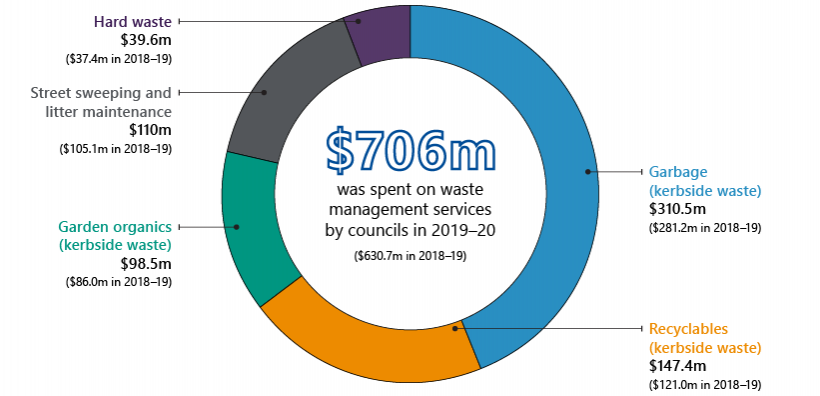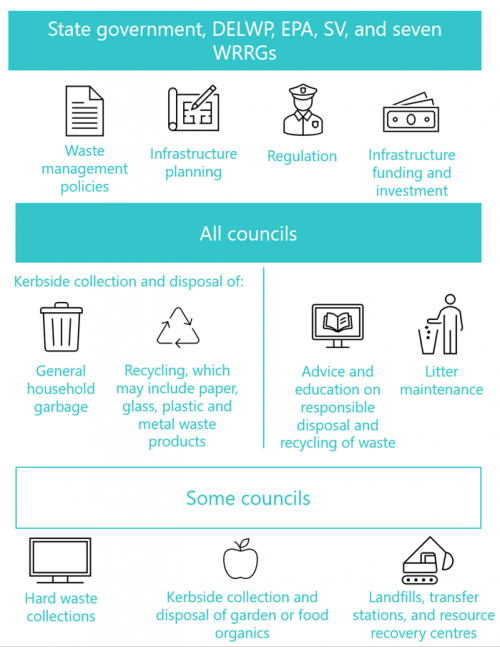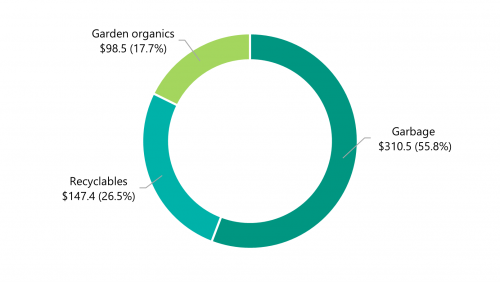Council Waste Management Services
Review snapshot
Do local councils’ waste management services provide value for money?
Why this review is important
Local councils are responsible for waste collection, processing and disposal. In 2019–20, Victorian councils spent over $706 million on delivering waste management services.
Victoria's approach to waste management is undergoing significant reform following our 2019 Recovering and Reprocessing Resources from Waste audit.
What we examined
The cost-efficiency of council waste management services by reviewing:
- data from the annual Waste and recycling in Victoria—Local Government waste services report
- council waste contracts
- practices at four selected councils.
Who we examined
- Bayside City Council
- City of Ballarat
- City of Melbourne
- Greater Dandenong City Council
- Department of Environment, Land, Water and Planning
- Grampians Central West Waste and Resource Recovery Group
- Metropolitan Waste and Resource Recovery Group
- Sustainability Victoria.
What we concluded
Nothing has come to our attention to indicate that councils’ waste management services are not providing value for money. This is due to current policy settings as well as market and capacity constraints around kerbside waste collection, which makes up almost 80 per cent of council waste spending.
The wide use of competitive procurement through tendering and the small number of potential suppliers means most councils have limited options to make substantial savings.
What we recommended
We did not make any recommendations in this review, as nothing came to our attention to indicate that councils’ major waste management services are not providing value for money given market and capacity constraints, and policy settings.
Video presentation
Key facts

Source: VAGO based on the Waste and recycling in Victoria—Local Government waste services report, 2018–19 and 2019–20.
What we found
We consulted with the audited agencies and considered their views when reaching our conclusions. The agencies’ full responses are in Appendix A.
Councils' waste management services
Victoria's 79 local councils manage the collection and processing of household waste. Some services, such as the collection and disposal of general household garbage, are common to all councils. Other waste services vary depending on the needs and priorities of the relevant communities.
Councils' waste management services can include:
- kerbside collection and disposal of garbage, recyclables and organic or gardening matter
- litter maintenance, including street sweeping and public place litter collections
- hard waste collections.
Many councils also operate landfills or resource recovery centres/transfer stations to dispose of garbage and process recyclables.
As shown in Figure A, in addition to councils' responsibilities, several other government agencies have a role in waste management.
Figure A: Agencies' waste management roles and responsibilities

Note: The acronyms used in this graphic are the Department of Environment, Land, Water and Planning (DELWP), the Environment Protection Authority Victoria (EPA), Sustainability Victoria (SV) and Waste Resource Recovery Groups (WRRGs).
Source: VAGO.
Efficiency of council waste management services
Most councils are unlikely to find any further substantial efficiency gains in their waste management expenditure. This is because:
- they already procure most of their kerbside services through competitive tendering
- there is a limited number of waste management service providers, which makes it hard for councils to create any more competitive tension and realise further savings
- there are gaps in the quality of available waste management data.
To assist councils to improve the quality of waste management data we provided all 79 councils with an individualised report of key data from SV.
Waste management expenditure
As shown in Figure B, Victoria's 79 councils spent around $706 million in 2019–20 on kerbside collection services, litter maintenance (including street sweeping and public place litter collections of garbage and recyclables) and household hard waste material.
Figure B: Councils' waste management expenditure, 2019–20
| Waste service | Expenditure ($ million) | Proportion of expenditure (%) |
|---|---|---|
| Kerbside waste | 556.4 | 78.8 |
| Litter maintenance, including street sweepings and public place litter collections | 110.0 | 15.6 |
| Hard waste | 39.6 | 5.6 |
| Total | 706.0 | 100.0 |
Note: Costs include the yearly collection, sorting, processing and disposal costs of providing a waste service, as well as the annualised depreciated bin costs if applicable.
Source: VAGO, based on the Waste and recycling in Victoria—Local Government waste services report, 2019–20.
Kerbside expenditure
In 2019–20, councils spent $556.4 million (78.8 per cent of their total waste management costs) providing kerbside services for garbage, recyclables and garden organics to 2.7 million Victorian properties—an average of $205 per property per year.
As outlined in Figure C, household garbage accounted for more than half of councils' kerbside waste management costs at $310.5 million (55.8 per cent of the total), followed by recyclables at 26.5 per cent and garden organics at 17.7 per cent.
Figure C: Councils' kerbside waste management expenditure, 2019–20, $ million

Source: VAGO, based on the Waste and recycling in Victoria—Local Government waste services report, 2019–20.
Litter maintenance and street sweeping services expenditure
All 79 councils provide litter maintenance and street sweeping services.
Councils spent around $110 million on these services (15.6 per cent of total waste management costs for 2019–20). Of this, councils spent $65 million on street sweeping and $45 million on litter services, including litter bins, litter traps and clean up services (such as dumped rubbish).
Household hard waste services expenditure
Hard waste is household material that cannot be placed into kerbside garbage bins, such as white goods and timber. Councils provide hard waste collections as either a kerbside pick-up for the whole municipality or an on-call service at a time agreed to by the household.
Councils spent approximately $39.6 million on hard waste services (5.6 per cent of total waste management costs for 2019–20).
In 2019–20, only 43 of 79 councils (54 per cent) provided a hard waste collection service. Of these, 31 were metropolitan councils.
Landfills, resource recovery centres and transfer stations expenditure
The Waste and recycling in Victoria—Local Government waste services report, 2019–20 does not collect expenditure data from councils on their landfills, resource recovery centres and transfer stations.
SV is a statutory authority that has responsibility for statewide waste management strategy and planning. SV delivers the Victorian Recycling Infrastructure Plan, initiatives to deliver the Recycling Victoria policy and is developing a governance framework for waste data.
Given the limited information on expenditure, in May 2021 SV undertook a survey to collect data on resource recovery centres and transfer stations. SV advised that it expects to report the results of its survey in early December 2021.
Outsourcing council waste management
Most councils outsource their waste management services. However, councils have limited choice when it comes to suppliers of collection and disposal of general household garbage, recycling and organic waste. This is because only five suppliers make up around 57 per cent of the general garbage and recycling market.
Figure D shows the cost distribution, level of outsourcing and industry context for councils' waste management for general garbage, recycling and organic waste.
Figure D: Industry context and key statistics for garbage and recyclable services
| Garbage | Recyclables and organics | |
|---|---|---|
| Cost | Collection and disposal costs are approximately 40 and 60 per cent respectively. | Similar to garbage, collection costs are around 40 per cent of total expenditure with sorting and disposal accounting for 60 per cent. |
| Outsourcing | 83 per cent of councils contract services through competitive tendering. | 92 per cent of councils contract services through competitive tendering. |
| Competitive procurement | Two-thirds of Victorian councils' waste disposal expenditure is procured through a joint competitive tender. | |
| Suppliers | There are a limited number of suppliers, some of them global companies, for garbage collection services. | |
| Landfill suppliers | Three operators run most landfills serving metropolitan Melbourne. | |
Source: VAGO.
As shown in Figure E a relatively small number of councils operate in-house kerbside waste collection services.
Figure E: Councils with in-house kerbside waste collection services, 2019–20
| Kerbside service | Number and percentage of councils | Councils |
|---|---|---|
| General household garbage | 13 (17%) | Banyule City Council, Boroondara City Council, Brimbank City Council, City of Ballarat, City of Darebin, City of Greater Bendigo, City of Stonnington, Horsham Rural City Council, Hume City Council, Mildura Rural City Council, Nillumbik Shire Council, Rural City of Wangaratta and Towong Shire Council. |
| Recyclables | 6 (8%) | Banyule City Council, Brimbank City Council, City of Ballarat, Moreland City Council, Nillumbik Shire Council and Towong Shire Council. |
Note: Not all councils provide an organic collection service.
Source: VAGO, based on SV data collected in the Waste and recycling in Victoria—Local Government waste services report, 2019–20.
Weaknesses in waste management data
WRRGs are responsible for supporting local governments to procure waste and recycling services, undertaking regional resource recovery planning and educating businesses and communities on waste avoidance and reduction.
EPA is responsible for controlling pollution from waste by developing and enforcing environmental regulations and standards.
Government's planning and policy decisions need to be informed by reliable waste data. However, there are significant gaps in the available waste management data that make it difficult to fully understand the cost of collection, processing and disposal.
Although waste data collection is a shared responsibility among SV, EPA, councils and WRRGs, SV is responsible for statewide oversight, coordination and reporting of waste data.
SV publishes two performance reports relating to waste—the Waste and recycling in Victoria—Local Government waste services report and the Waste and recycling in Victoria—Recycling industry waste report. These reports use data collected mainly through voluntary surveys of councils and reprocessing facility operators.
Although they contain valuable information regarding the cost of services and tonnage of waste collected, our 2019 Recovering and Reprocessing Resources from Waste audit found that SV's data is incomplete, unreliable and, in some instances, inaccurate.
Given the voluntary nature of the surveys, SV has a limited ability to verify the responses. While SV tries to validate the waste data it receives from respondents, it primarily does this by identifying significant changes in data from year to year.
The audit recommended SV improve the quality and reliability of waste data. SV accepted the recommendation and developed a new waste and recycling data roadmap for waste and resources recovery data. The roadmap then underpinned a business case to government submitted at the start of 2020 for the expanding Victoria’s waste data project to enable better waste management monitoring. The project began on 1 July 2020 and is due for completion in 2024.
Since our 2019 audit, SV has made improvements to waste management data, including:
- introducing clearer definitions and guidelines to improve consistency in how councils and operators of recovery facilities report their data
- publishing a regular bulletin on the recycled commodity markets that collates information on the changing costs of recovered materials and the impact of global and domestic market trends.
However, until SV fully addresses these data quality issues, we have limited ability to comprehend the state's waste data. These weaknesses hampered our efforts to undertake sector-wide analysis or comparisons.
Data for individual councils
As part of this review, we provided all 79 councils with an individual report of key statistics from the SV data. This will allow councils to identify and fix any issues with their data reporting to SV as well as undertake benchmarking against other councils where possible.
Changes to Victoria's waste management policy environment
Victoria’s approach to waste management is undergoing significant reform following our 2019 Recovering and Reprocessing Resources from Waste audit. The audit found that Victoria had no overarching statewide policy for waste management and unclear statewide guidance. Without a statewide waste policy, local councils and other responsible agencies are operating in an uncertain environment and cannot effectively prioritise their limited time and resources.
In response to our audit, the Victorian Government is introducing new governance arrangements to manage the waste sector. This includes:
- a new legislative framework that will clarify councils' responsibility for providing households with both waste and recycling services
- setting up a new waste authority to take on some of the existing functions of state government entities, including all the functions of the seven WRRGs, and the infrastructure planning function currently performed by SV.
The new waste authority will also support councils to collaborate in procuring waste and recycling services. This will impact the efficiency of their waste services by supporting more effective procurement.
These reforms are due to be implemented over the next two years.
Recycling Victoria policy 2020
In February 2020, the state government also released a 10-year Recycling Victoria policy and action plan for waste and recycling. It includes a complete overhaul of Victoria's recycling system and will impact how councils collect and process recyclable materials.
The government has set ambitious targets to divert 72 per cent of waste from landfill by 2025 and 80 per cent by 2030. It seeks to achieve this by:
- standardising the kerbside waste collection from households to improve the recovery of recyclable materials
- introducing a container deposit scheme from 2023
- increasing the levy imposed on municipal waste sent to landfill. This will raise the price at which alternatives to landfill, such as recycling or advanced waste processing, can compete with landfills.
Capacity constraints
Even with government reforms underway on how councils manage their waste, councils will still need to dispose of waste that is not suitable for recovery or recycling. In metropolitan Melbourne over the next 10 years, this is forecast to be around 3 to 3.5 million tonnes of waste per annum.
The current volume of approved landfill capacity is forecast to be sufficient for Melbourne’s needs only to 2026. Increasing capacity is controlled at the state rather than local government level. Without state action to increase disposal capacity, prices may increase for councils to dispose waste.
Appendix A. Submissions and comments
Click the link below to download a PDF copy of Appendix A. Submissions and comments.
Appendix B. Acronyms
| Acronyms | |
|---|---|
| DELWP | Department of Environment, Land, Water and Planning |
| EPA | Environment Protection Authority Victoria |
| SV | Sustainability Victoria |
| WRRG | Waste Resource Recovery Group |
Appendix C. About this review
Our Annual Plan 2021–22 included a proposed audit of council waste management services. The audit objective was to determine whether local councils’ waste management services provide value for money.
The proposed agencies included Bayside City Council, City of Ballarat, City of Melbourne, DELWP, Grampians Central West WRRG, Greater Dandenong City Council, the Metropolitan WRRG and SV.
As part of our audit planning we considered whether an efficiency audit into Victorian councils' waste management services would result in an impactful report and lead to process improvements and efficiency gains for councils.
Based on the evidence we obtained during planning, which is presented in this report, we found that continuing with a full performance audit would not provide value for money and instead decided to publish this report as a limited assurance review.
We conducted this limited assurance review in accordance with the Audit Act 1994 and Australian Standard on Assurance Engagements ASAE 3000 Assurance Engagements Other than Audits or Reviews of Historical Financial Information.
A limited assurance review provides a lower level of assurance than a standard performance audit. In a limited assurance review we rely primarily on an agency’s representations and other evidence generated by that agency to understand matters and develop a meaningful conclusion. We typically express conclusions for a limited assurance review in negative terms.
We provided a copy of the report to the Department of Premier and Cabinet and the Department of Treasury and Finance.
The cost of this review was $150 000.

